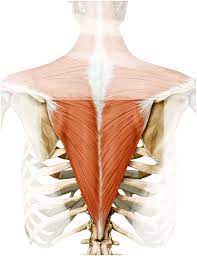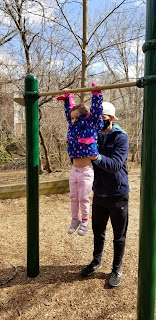Christmas is coming early in 2021! Did Amelie successfully lobby an earlier Christmas to maximize her 2021 toy time? No – not yet, despite her best efforts.
Christmas is coming early for me
because on November 5-6, I get to teach “Movement Systems of the Upper
Extremity” with my Bosom Buddy and Co-Dependent Partner in Crime – Michael
Glenn Kecman! Don’t be fooled by the vanilla course name, this weekend will be
a blast! If you need any more convincing, take a gander at this little teaser
(cue dramatic music and fade lights):
This
is the course to end all courses! It is a compilation of 14 years of blood,
sweat, and tears (mostly Kecman’s - he is a sensitive soul), by this dynamic duo. That is no typo,
folks. These two have been attached at the hip for 14 years and have birthed
two “love child,” courses. While no parent will admit they have a favorite
child, both Kecman and Alcorn agree that this is their favorite course! Shhh,
don’t tell Evaluation and Manual Therapy of the Shoulder. It is prone to jealousy.
Shameless promotions aside, teaching in The Jackson Clinics Education Curriculum truly is an honor. I get to share my love of the shoulder with the best and brightest of our company, while collaborating
with my good friend. If the above teaser did not stoke your shoulder
enthusiasm, how about promise of a friendly competition between Kecman and
myself of “Whose kid is the cutest?” peppered throughout our lecture PowerPoint?
If neither of these sales pitches
landed, I vow to win you over, waxing poetic about the Lower
Trapezius.
As a shoulder nerd, an undying love of the Lower Trapezius is essential. We drone on, and on, about the Lower Trapezius, and its crucial role in the Trapezius Force Couple. The Trapezius Force Couple serves to provide a stable scapular base for the arm to move upon, in addition to facilitating the requisite upward rotation of the scapula to successfully press the arm overhead1.
Can we try that again, without
the jargon?
We need a rock-solid lower trapezius
in order to have a strong base for our arm, especially during any movement
above shoulder height.
We also know that people with
shoulder pain tend to demonstrate a pattern of delayed and diminished firing of
the Lower Trapezius, in comparison to other muscles of the shoulder girdle1.
With these notions front of mind,
I call upon a series of exercises to improve the performance of the Trapezius
Force Couple with regards to motor learning, strength, endurance, and total arm
function.
Introducing the Lower
Trapezius
As described in Coaching and Life Lessons from Amelie, motor learning is a relatively permanent change in the
ability to execute a motor skill as a result of practice or experience2.
In the context of pressing overhead (a skill lost in many people with shoulder
pain), I like to set people up for success, by starting with a movement is easy
to perform and effective in activating the Lower Trapezius.
Bilateral External Rotation:
The bilateral external rotation movement serves this purpose
because it has been shown to provide a
great activation ratio of Lower Trapezius to Upper Trapezius3.
Remember – people with shoulder pain tend to demonstrate reduced performance of
the Lower Trapezius in relation to the Upper Trapezius with reaching overhead.
Guidance
on prescription – Use this movement in a high repetition format – think 20-30
repetitions per set, performed 2-3 x daily. We are prescribing this movement as
an introduction to trapezius activation. Think about how many repetitions you
had to accumulate to build confidence when you were first introduced to riding
a bicycle. I also like to have my patients perform these movements standing
against a wall, which provides the additional tactile cue of the shoulder
blades squeezing against the wall. Take a look at this picture, and the
distribution of the Lower Trapezius along the inner border of the scapula4:
Building Capacity in the Lower
Trapezius
Capacity (mobility, strength, endurance) is a precursor to motor learning – establish capacity first5. We rarely see mobility deficits in the Lower Trapezius, so we will focus on tactics to improve strength and endurance.
Partial Range "Y" :
The “Y” is lauded as a go-to exercise to maximize Lower Trapezius activation3 and, as a result, it is many clinician’s first
choice to strengthen the Lower Trapezius. The trouble is, I often find that
people with shoulder pain have trouble performing the “Y,” because it brings on
said shoulder pain. In an effort to please the clinician and appease the
painful shoulder, why not shorten the range of motion? Studies have shown that you can achieve a 30 degree physiologic overflow with short arc
exercises6. This means you can achieve the benefits of strengthening
the end range of the “Y,” without pain provocation. Win-Win!
Guidance on Prescription – In keeping with the American College of Sports Medicine’s Foundations of Strength Training model7, start with 2-3 sets of 10 repetitions. Progress this movement as quickly as tolerated, by adjusting parameters such as increasing range of motion, increasing weight, or decreasing rest time between sets.
Posterior Shoulder Endurance:
The “T” has been adapted to fit the endurance requirement of motor learning through the Posterior Shoulder Endurance Test (PSET). The PSET was designed to be both an endurance exercise and test for the Trapezius Force Couple8. It is described as follows8:
·
Isotonic test performed in a prone
position
·
Lift the arm to 90°of horizontal
abduction at a shoulder abduction angle of 90°
·
Use cadence of 30 beats per minute
·
Original study - no external weight
·
Subsequent studies - 2% body weight
used
Guidance on
Prescription – If performing as a test, follow the instructions above, and
recheck every 4-6 weeks. If performing as an endurance exercise, select the
time domain that closely matches the activity of interest of the patient. Once
the time domain has been established, try and progress the weight utilized, or
adjust the cadence utilized, to progressively challenge.
Lower
Trapezius and Total Arm Function
Push Press:
The “Push Press” is the ultimate expression of motor learning for the shoulder. Its salience is universal. We all need to reach our arms overhead at some point in our day, and the "Push Press" allows us to couple the specificity of this overhead movement with intensity (through manipulation of training variables).
Guidance on
Prescription – We have already prescribed high repetition movements to fast
track learning (Bilateral External Rotation) and improve endurance (PSET), and
progressive loading to improve strength (Y). In the name of providing a
comprehensive program, let’s utilize the principles of Speed Training, with the Push
Press. Start with 3 sets of 5 repetitions with a focus on moving as fast as
possible.
The Take Home:
1. The Lower Trapezius plays a crucial role in the optimal function of the shoulder and arm
2. Movement Systems of the Upper Extremity is a course not to be missed
3. Come to our course (November 5-6, 2021) to learn about all things exercise for the Lower Trapezius and total arm. Stay for the witty banter!
References:
1. Ellenbecker TS, Manske RC, Kelley MJ. The Shoulder: Physical Therapy Patient Management Utilizing Current Evidence. Orthopaedic Section, APTA; 2016
2. Haibach-Beach P, Reid G, Collier D. Motor Learning and Development – 2nd Edition.
3. Kevin Wilk - Current Concepts in the Treatment of Rotator Cuff Injuries – DVD (2015)
4. Image Credit - https://www.sportsinjurybulletin.com/lower-trapezius-the-key-to-scapula-control/
5. Understanding Human Movement as a Dynamical System – Erik Meira (2018) – as part of the course: Complex Understandings for Simple Solutions
6. Clark, RA, et al. The influence of variable ROM training on neuromuscular performance and control of external loads. JCSR. 25:704-711, 2011.
7. ACSM. Progression models in resistance training for healthy adults. MSSE. 41(3):687-708, 2009.
8. Moore, Uhl, Kibler. Improvements in Shoulder Endurance Following a Baseball-Specific Strengthening Program in High School Baseball Players (2013) Sports Health A Multidisciplinary Approach 5(3):233-238.






